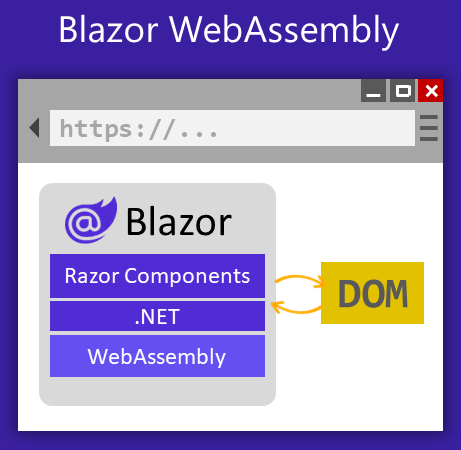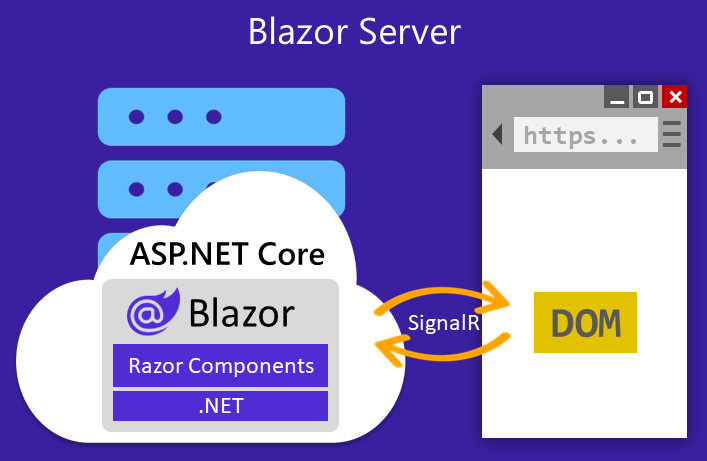原文:https://www.cnblogs.com/sheng-jie/p/10280336.html
引言
首先不用查字典了,词典查无此词。猜测是作者笔误将Mediator写成MediatR了。废话少说,转入正题。
先来简单了解下这个开源项目MediatR(作者Jimmy Bogard,也是开源项目AutoMapper的创建者,在此表示膜拜):
Simple mediator implementation in .NET. In-process messaging with no dependencies. Supports request/response, commands, queries, notifications and events, synchronous and async with intelligent dispatching via C# generic variance.
.NET中的简单中介者模式实现,一种进程内消息传递机制(无其他外部依赖)。 支持以同步或异步的形式进行请求/响应,命令,查询,通知和事件的消息传递,并通过C#泛型支持消息的智能调度。
如上所述,其核心是一个中介者模式的.NET实现,其目的是消息发送和消息处理的解耦。它支持以单播和多播形式使用同步或异步的模式来发布消息,创建和侦听事件。
中介者模式既然是对中介者模式的一种实现,那么我们就有必要简要介绍下中介者这个设计模式,以便后续展开。
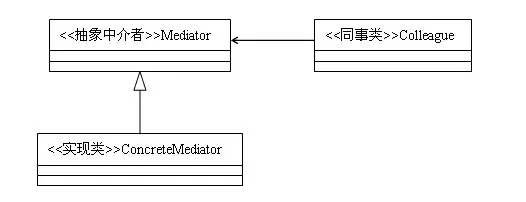
中介者模式类图
中介者模式:用一个中介对象封装一系列的对象交互,中介者使各对象不需要显示地相互作用,从而使耦合松散,而且可以独立地改变它们之间的交互。
看上面的官方定义可能还是有点绕,那么下面这张图应该能帮助你对中介者模式有个直观了解。
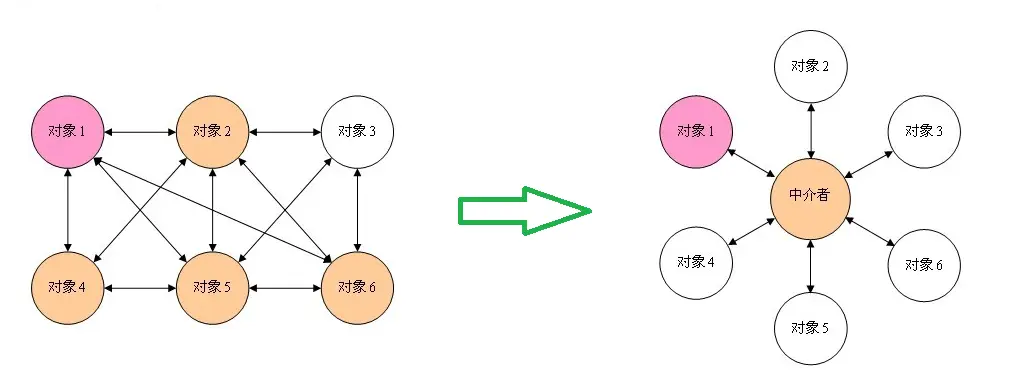
使用中介模式,对象之间的交互将封装在中介对象中。对象不再直接相互交互(解耦),而是通过中介进行交互。这减少了对象之间的依赖性,从而减少了耦合。
那其优缺点也在图中很容易看出:
优点:中介者模式的优点就是减少类间的依赖,把原有的一对多的依赖变成了一对一的依赖,同事类只依赖中介者,减少了依赖,当然同时也降低了类间的耦合
缺点:中介者模式的缺点就是中介者会膨胀得很大,而且逻辑复杂,原本N个对象直接的相互依赖关系转换为中介者和同事类的依赖关系,同事类越多,中介者的逻辑就越复杂。
Hello MeidatR
在开始之前,我们先来了解下其基本用法。
单播消息传输
单播消息传输,也就是一对一的消息传递,一个消息对应一个消息处理。其通过IRequest来抽象单播消息,用IRequestHandler进行消息处理。
//构建 消息请求
public class Ping : IRequest { }
//构建 消息处理
public class PingHandler : IRequestHandler<Ping, string> {
public Task Handle(Ping request, CancellationToken cancellationToken) {
return Task.FromResult("Pong");
}
}
//发送 请求
var response = await mediator.Send(new Ping());
Debug.WriteLine(response); // "Pong"
多播消息传输
多播消息传输,也就是一对多的消息传递,一个消息对应多个消息处理。其通过INotification来抽象多播消息,对应的消息处理类型为INotificationHandler。
//构建 通知消息
public class Ping : INotification { }
//构建 消息处理器1
public class Pong1 : INotificationHandler {
public Task Handle(Ping notification, CancellationToken cancellationToken) {
Debug.WriteLine("Pong 1");
return Task.CompletedTask;
}
}
//构建 消息处理器2
public class Pong2 : INotificationHandler {
public Task Handle(Ping notification, CancellationToken cancellationToken) {
Debug.WriteLine("Pong 2");
return Task.CompletedTask;
}
}
//发布消息
await mediator.Publish(new Ping());
源码解析
对MediatR有了基本认识后,我们来看看源码,研究下其如何实现的。
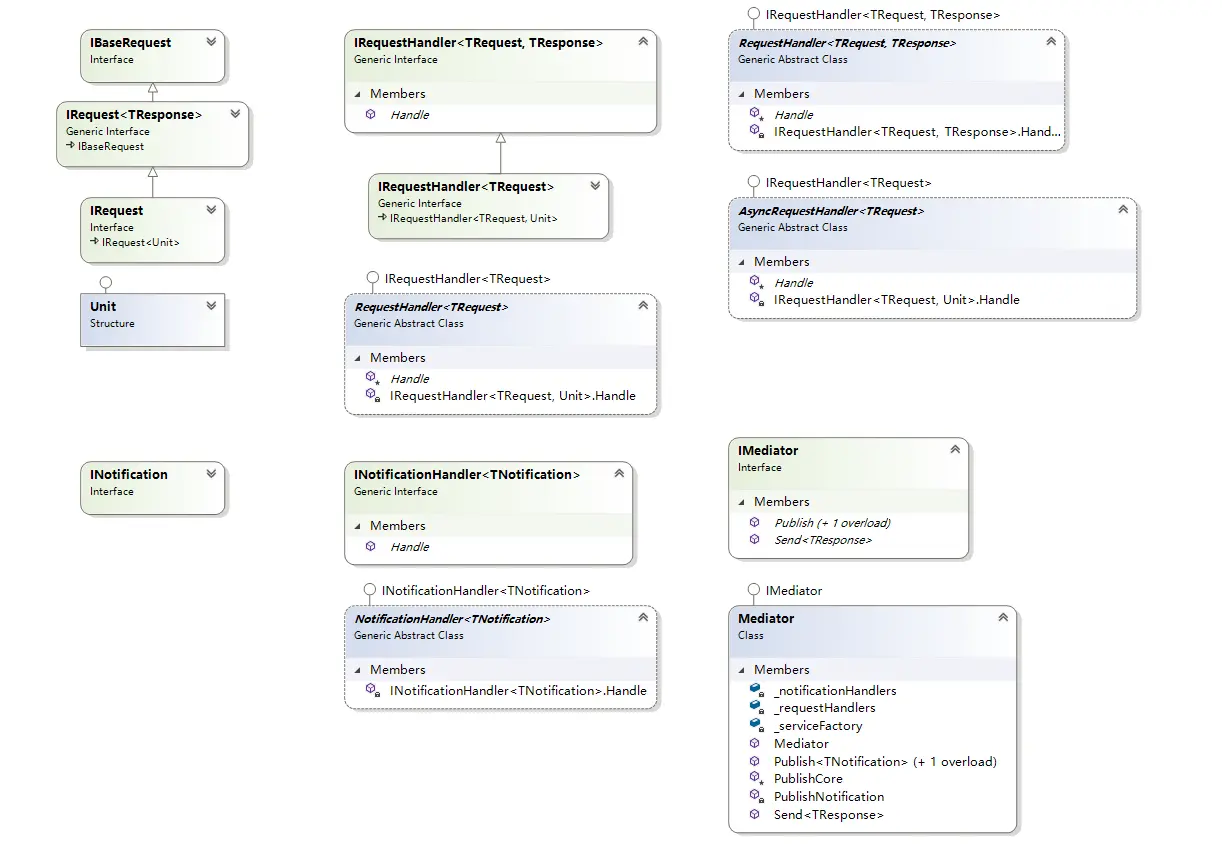
类图
从代码图中我们可以看到其核心的对象主要包括:
IRequest Vs IRequestHandler
INotification Vs INoticifaitonHandler
IMediator Vs Mediator
Unit
IPipelineBehavior
IRequest Vs IRequestHandler
其中IRequest和INotification分别对应单播和多播消息的抽象。
对于单播消息可以决定是否需要返回值选用不同的接口:
IRequest - 有返回值
IRequest - 无返回值
这里就不得不提到其中巧妙的设计,通过引入结构类型Unit来代表无返回的情况。
///
/// 代表无需返回值的请求
///
public interface IRequest : IRequest { }
///
/// 代表有返回值的请求
///
/// Response type
public interface IRequest : IBaseRequest { }
///
/// Allows for generic type constraints of objects implementing IRequest or IRequest{TResponse}
///
public interface IBaseRequest { }
同样对于IRequestHandler也是通过结构类型Unit来处理不需要返回值的情况。
public interface IRequestHandler<in TRequest, TResponse>
where TRequest : IRequest
{
Task Handle(TRequest request, CancellationToken cancellationToken);
}
public interface IRequestHandler : IRequestHandler<TRequest, Unit>
where TRequest : IRequest
{
}
从上面我们可以看出定义了一个方法名为Handle返回值为Task的包装类型,而因此赋予了其具有以同步和异步的方式进行消息处理的能力。我们再看一下其以异步方式进行消息处理(无返回值)的默认实现AsyncRequestHandler:
public abstract class AsyncRequestHandler : IRequestHandler
where TRequest : IRequest
{
async Task IRequestHandler<TRequest, Unit>.Handle(TRequest request, CancellationToken cancellationToken)
{
await Handle(request, cancellationToken).ConfigureAwait(false);
return Unit.Value;
}
protected abstract Task Handle(TRequest request, CancellationToken cancellationToken);
}
从上面的代码来看,我们很容易看出这是装饰模式的实现方式,是不是很巧妙的解决了无需返回值的场景。
最后我们来看下结构类型Unit的定义:
public struct Unit : IEquatable, IComparable, IComparable
{
public static readonly Unit Value = new Unit();
public static readonly Task Task = System.Threading.Tasks.Task.FromResult(Value);
// some other code
}
IMediator Vs MediatorMediatR 类图
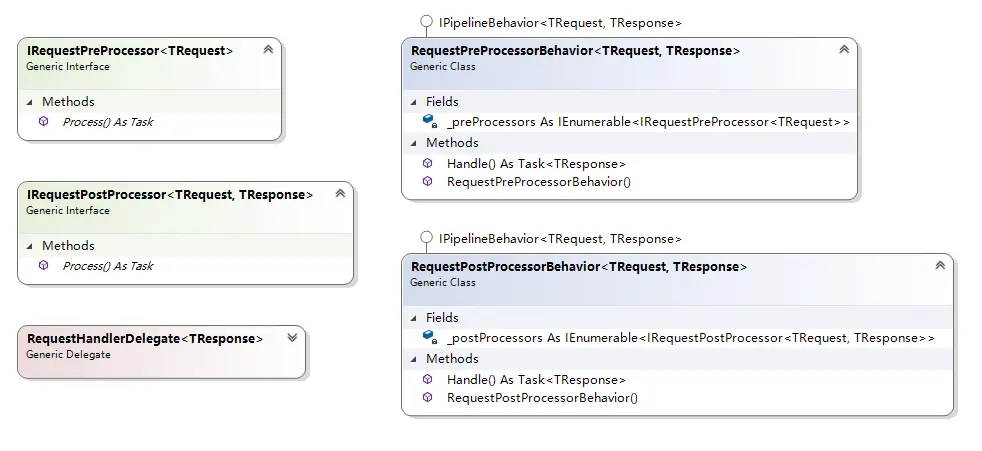
IMediator主要定义了两个方法Send和Publish,分别用于发送消息和发布通知。其默认实现Mediator中定义了两个集合,分别用来保存请求与请求处理的映射关系。
//Mediator.cs
//保存request和requesthandler的映射关系,1对1。
private static readonly ConcurrentDictionary<Type, object> _requestHandlers = new ConcurrentDictionary<Type, object>();
//保存notification与notificationhandler的映射关系,
private static readonly ConcurrentDictionary<Type, NotificationHandlerWrapper> _notificationHandlers = new ConcurrentDictionary<Type, NotificationHandlerWrapper>();
这里面其又引入了两个包装类:RequestHandlerWrapper和NotificationHandlerWrapper。这两个包装类的作用就是用来传递ServiceFactory委托进行依赖解析。
所以说Mediator借助public delegate object ServiceFactory(Type serviceType);完成对Ioc容器的一层抽象。这样就可以对接任意你喜欢用的Ioc容器,比如:Autofac、Windsor或ASP.NET Core默认的Ioc容器,只需要在注册IMediator时指定ServiceFactory类型的委托即可,比如ASP.NET Core中的做法:
ASP.NET Core注册IMediatr
在使用ASP.NET Core提供的原生Ioc容器有些问题:Service registration crashes when registering generic handlers
IPipelineBehavior处理管道
MeidatR支持按需配置请求管道进行消息处理。即支持在请求处理前和请求处理后添加额外行为。仅需实现以下两个接口,并注册到Ioc容器即可。
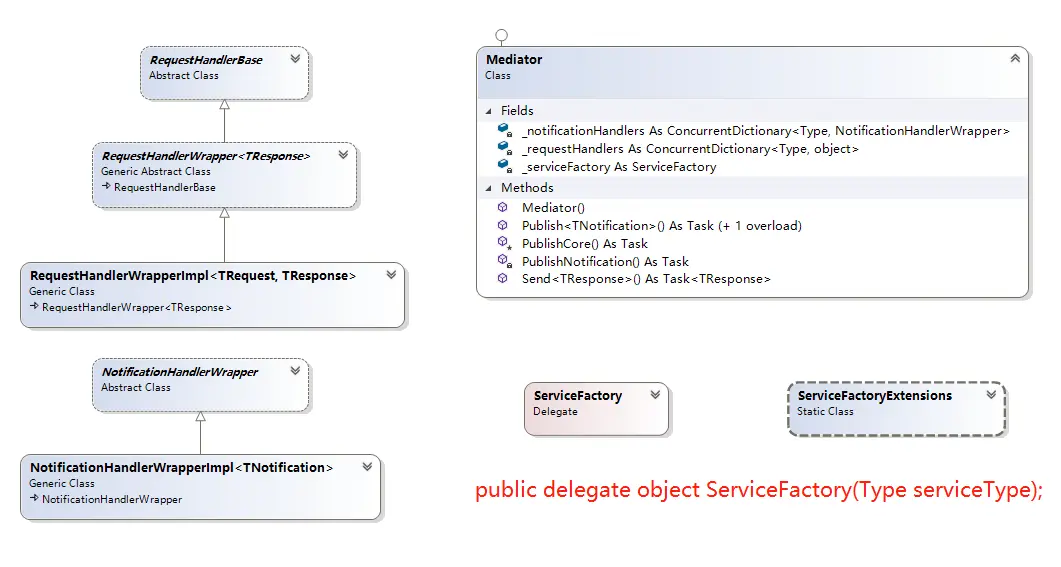
IRequestPreProcessor 请求处理前接口
IRequestPostProcessor<in TRequest, in TResponse> 请求处理后接口
其中IPipelineBehavior的默认实现:RequestPreProcessorBehavior和RequestPostProcessorBehavior分别用来处理所有实现IRequestPreProcessor和IRequestPostProcessor接口定义的管道行为。
而处理管道是如何构建的呢?我们来看下RequestHandlerWrapperImpl的具体实现:
internal class RequestHandlerWrapperImpl<TRequest, TResponse> : RequestHandlerWrapper
where TRequest : IRequest
{
public override Task Handle(IRequest request, CancellationToken cancellationToken,
ServiceFactory serviceFactory)
{
Task Handler() => GetHandler<IRequestHandler<TRequest, TResponse>>(serviceFactory).Handle((TRequest) request, cancellationToken);
return serviceFactory
.GetInstances>()
.Reverse()
.Aggregate((RequestHandlerDelegate) Handler, (next, pipeline) => () => pipeline.Handle((TRequest)request, cancellationToken, next))();
}
}
就这样一个简单的函数,涉及的知识点还真不少,说实话我花了不少时间来理清这个逻辑。
那都涉及到哪些知识点呢?我们一个一个的来理一理。
C# 7.0的新特性 - 局部函数
C# 6.0的新特性 - 表达式形式的成员函数
Linq高阶函数 - Aggregate
匿名委托
构造委托函数链
关于第1、2个知识点,请看下面这段代码:
public delegate int SumDelegate();//定义委托
public static void Main()
{
//局部函数(在函数内部定义函数)
//表达式形式的成员函数, 相当于 int Sum() { return 1 + 2;}
int Sum() => 1 + 2;
var sumDelegate = (SumDelegate)Sum;//转换为委托
Console.WriteLine(sumDelegate());//委托调用,输出:3
}
再看第4个知识点,匿名委托:
public delegate int SumDelegate();
SumDelegate delegater1 = delegate(){ return 1+2; }
//也相当于
SumDelegate delegater2 => 1+2;
下面再来介绍一下Aggregate这个Linq高阶函数。Aggregate是对一个集合序列进行累加操作,通过指定初始值,累加函数,以及结果处理函数完成计算。
函数定义:
public static TResult Aggregate<TSource,TAccumulate,TResult>
(this IEnumerable source,
TAccumulate seed,
Func<TAccumulate,TSource,TAccumulate> func,
Func<TAccumulate,TResult> resultSelector);
根据函数定义我们来写个简单的demo:
var nums = Enumerable.Range(2, 3);//[2,3,4]
// 计算1到5的累加之和,再将结果乘以2
var sum = nums.Aggregate(1, (total, next) => total + next, result => result 2);// 相当于 (((1+2)+3)+4)2=20
Console.WriteLine(sum);//20
和函数参数进行一一对应:
seed : 1
Func<TAccumulate,TSource,TAccumulate> func : (total, next) => total + next
Func<TAccumulate,TResult> resultSelector : result => result * 2
基于上面的认识,我们再来回过头梳理一下RequestHandlerWrapperImpl。
其主要是借助委托:public delegate Task RequestHandlerDelegate();来构造委托函数链来构建处理管道。
对Aggregate函数了解后,我们就不难理解处理管道的构建了。请看下图中的代码解读:
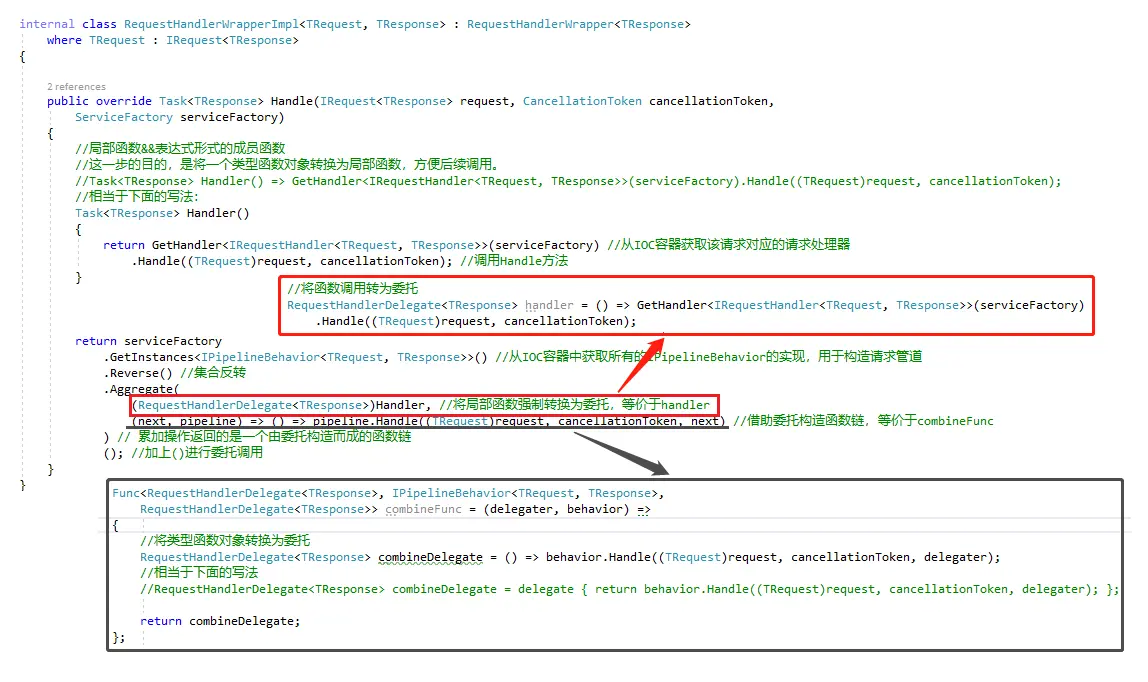

请求处理管道代码解读 构建流程解析
那如何保证先执行IRequestPreProcessor再执行IRequestPostProcessor呢?
就是在注册到Ioc容器时必须保证顺序,先注册IRequestPreProcessor再注册IRequestPostProcessor。(这一点很重要!!!)
看到这里有没有想到ASP.NET Core中请求管道中中间件的构建呢?是不是很像俄罗斯套娃?先由内而外构建管道,再由外而内执行!
至此,MediatR的实现思路算是理清了。
应用场景
如文章开头提到:MediatR是一种进程内消息传递机制。 支持以同步或异步的形式进行请求/响应,命令,查询,通知和事件的消息传递,并通过C#泛型支持消息的智能调度。
那么我们就应该明白,其核心是消息的解耦。因为我们几乎都是在与消息打交道,那因此它的应用场景就很广泛,比如我们可以基于MediatR实现CQRS、EventBus等。
另外,还有一种应用场景:我们知道借助依赖注入的好处是,就是解除依赖,但我们又不得不思考一个问题,随着业务逻辑复杂度的增加,构造函数可能要注入更多的服务,当注入的依赖太多时,其会导致构造函数膨胀。比如:
public DashboardController(
ICustomerRepository customerRepository,
IOrderService orderService,
ICustomerHistoryRepository historyRepository,
IOrderRepository orderRepository,
IProductRespoitory productRespoitory,
IRelatedProductsRepository relatedProductsRepository,
ISupportService supportService,
ILog logger
)
如果借助MediatR进行改造,也许仅需注入IMediatR就可以了。
public DashboardController(IMediatR mediatr)
总结
看到这里,也许你应该明白MediatR实质上并不是严格意义上的中介者模式实现,我更倾向于其是基于Ioc容器的一层抽象,根据请求定位相应的请求处理器进行消息处理,也就是服务定位。
